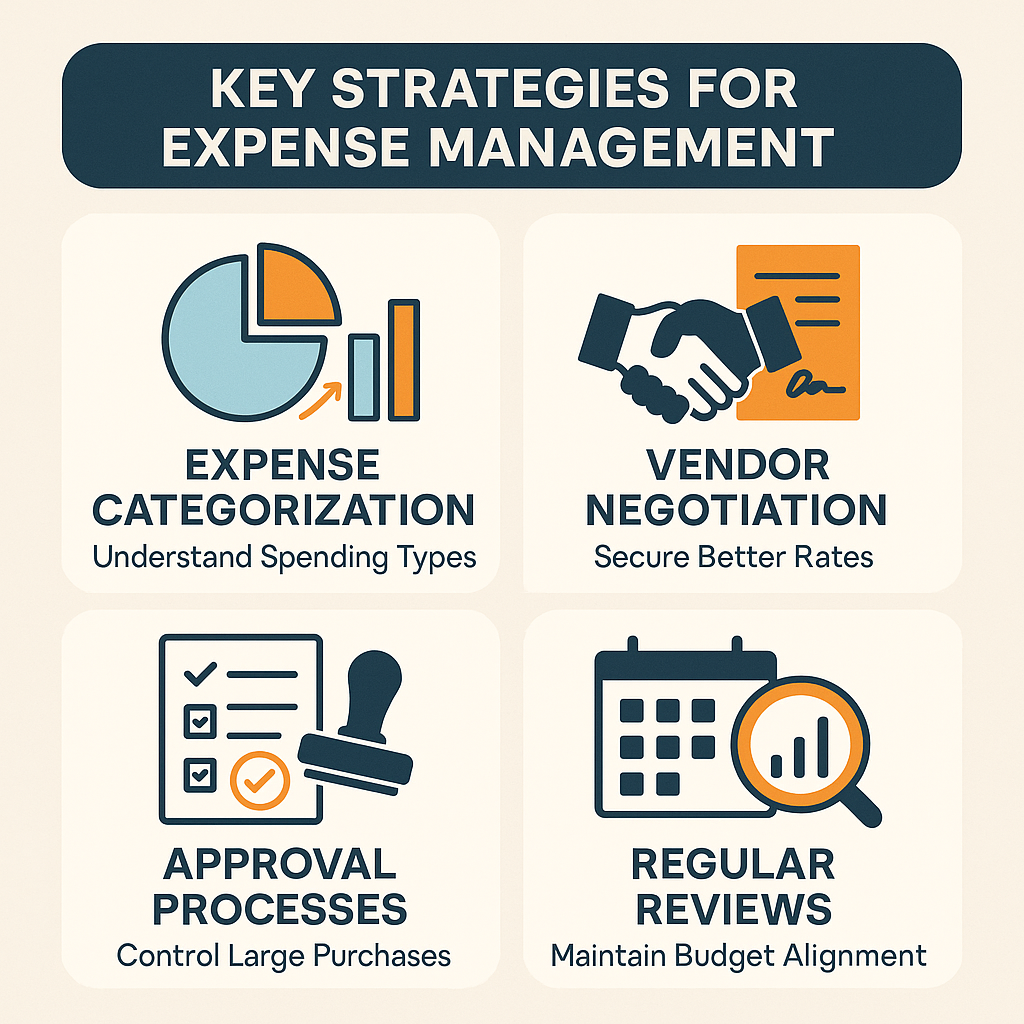Managing finances effectively can make the difference between a thriving business and one that struggles to stay afloat. For small business owners, implementing budgeting strategies for small businesses isn't just about tracking numbers—it's about creating a roadmap to financial success and stability.
Many entrepreneurs find themselves overwhelmed by the complexities of financial planning, yet the right approach to budgeting can transform how you manage cash flow, control expenses, and plan for growth. When done correctly, strategic budgeting becomes a powerful tool that helps you navigate uncertain markets while building a stronger financial foundation.
Essential Tips for Flexible Budget Planning
Flexible budget planning forms the cornerstone of effective budgeting strategies for small businesses, allowing you to adapt quickly to changing market conditions. This approach helps you maintain financial stability even when unexpected circumstances arise, making it easier to adjust spending priorities without derailing your overall financial goals.
- Track every expense in real-time: Monitor your daily spending patterns to identify trends and catch potential issues before they become problems. This practice helps you maintain better cost control and makes expense forecasting more accurate.
- Build buffer zones into each category: Allocate an extra 10-15% cushion in your budget categories to handle minor fluctuations without stress. This flexibility prevents you from constantly revising your budget when small variations occur.
- Review and adjust monthly: Set aside time each month to evaluate your budget performance and make necessary adjustments. Regular reviews help you stay aligned with your business goals while improving your financial planning skills over time.
Revenue Tracking and Income Management
Revenue tracking and income management serve as the foundation for all your budgeting efforts, helping you understand your business's earning patterns and seasonal variations. By accurately monitoring your income streams, you can make more informed decisions about spending and investment opportunities that support long-term growth.
- Document all income sources separately: Keep detailed records of each revenue stream to identify which parts of your business generate the most profit. This information helps you focus your efforts on the most profitable activities while identifying areas that might need improvement.
- Calculate average monthly earnings: Use historical data to determine your typical monthly income, accounting for seasonal fluctuations and market trends. This baseline helps you set realistic spending limits and plan for periods when income might be lower than usual.
- Set conservative revenue projections: Base your budget on slightly lower income estimates to avoid overspending during slower periods. Conservative projections help you maintain better cash flow while building confidence in your financial planning abilities.
- Monitor profit margins regularly: Track the relationship between your income and direct costs to ensure your business remains profitable. Regular monitoring helps you spot trends early and adjust pricing or operations as needed.
Strategic Expense Forecasting Methods
Strategic expense forecasting methods enable you to anticipate future costs and allocate resources more effectively across your business operations. By implementing systematic forecasting techniques, you can avoid budget surprises and make smarter decisions about when to invest in growth opportunities or pull back on spending.
- Analyze historical spending patterns: Review your past 12 months of expenses to identify trends and recurring costs that might not be immediately obvious. This analysis helps you spot seasonal patterns and prepare for predictable expense increases throughout the year.
- Factor in inflation and market changes: Adjust your expense projections to account for rising costs in your industry and general economic conditions. Forward-thinking expense forecasting helps you maintain realistic expectations and avoid budget shortfalls.
- Plan for equipment replacement and upgrades: Set aside funds for maintaining and updating your business equipment before it becomes a crisis. Proactive planning for these larger expenses helps you maintain smooth operations while spreading costs over time.
Building Emergency Funds and Cash Reserves
Building emergency funds and cash reserves protects your business from unexpected financial challenges while providing the flexibility to seize opportunities when they arise. A well-funded reserve account acts as your business's safety net, allowing you to weather difficult periods without compromising your operations or taking on unnecessary debt.
- Start with a modest emergency fund goal: Aim to save enough to cover one month of essential expenses, then gradually build toward three to six months of operating costs. Starting small makes the goal feel achievable while establishing the habit of regular saving.
- Automate your emergency fund contributions: Set up automatic transfers to move a fixed percentage of your revenue into a separate savings account. Automation removes the temptation to skip contributions and ensures consistent progress toward your emergency fund goals.
- Keep emergency funds easily accessible: Store your reserves in accounts that offer quick access without penalties, such as high-yield savings accounts or money market funds. Easy access ensures you can respond quickly to genuine emergencies without bureaucratic delays.
- Define what constitutes an emergency: Create clear guidelines for when you'll use emergency funds to prevent the temptation to dip into reserves for non-essential expenses. Clear definitions help you preserve your safety net for true financial emergencies.
Cost Control and Expense Management

Cost control and expense management directly impact your business's profitability by helping you identify areas where you can reduce spending without sacrificing quality or service. Effective expense management involves regularly reviewing your costs, negotiating better deals with suppliers, and finding creative ways to operate more efficiently.
- Categorize all business expenses clearly: Organize your spending into fixed costs, variable costs, and discretionary expenses to better understand where your money goes. Clear categorization makes it easier to identify which expenses are essential and which ones you might be able to reduce or eliminate.
- Negotiate with vendors and service providers: Regularly review your contracts and ask for better rates, especially if you've been a loyal customer or if your business has grown. Many vendors are willing to offer discounts to maintain long-term relationships with good customers.
- Implement approval processes for larger purchases: Require multiple approvals or waiting periods for significant expenses to prevent impulse buying and ensure all major purchases align with your budget goals. This process helps you make more thoughtful spending decisions and avoid budget overruns.
Technology and Tools for Budget Management
Technology and tools for budget management can streamline your financial processes while providing better insights into your business's financial health. The right combination of software and systems helps you track expenses more accurately, generate useful reports, and spend less time on manual bookkeeping tasks.
- Choose accounting software that matches your needs: Select a system that can handle your current transaction volume while offering room to grow as your business expands. Good accounting software automates many routine tasks and provides valuable financial reports that support better decision-making.
- Connect your bank accounts for automatic tracking: Link your business accounts to your accounting software to automatically import transactions and reduce manual data entry errors. Automatic tracking saves time while ensuring your financial records stay current and accurate.
- Set up budget alerts and notifications: Configure your systems to warn you when spending approaches budget limits or when unusual transactions occur. Early warnings help you stay on track with your budget goals and catch potential problems before they become serious issues.
- Generate regular financial reports: Use your tools to create monthly reports that show budget performance, cash flow trends, and expense patterns. Regular reporting helps you identify trends and make data-driven decisions about your business finances.
Implementing effective budgeting strategies for small businesses requires dedication and regular attention, but the rewards far outweigh the effort involved. By focusing on flexible planning, accurate expense forecasting, and building strong emergency funds, you create a financial foundation that supports both daily operations and long-term growth.
Remember that successful budgeting isn't about restricting your business, it's about gaining the financial clarity and control needed to make confident decisions. Start with one or two strategies that resonate most with your current situation, then gradually incorporate additional techniques as you become more comfortable with the process.
Your business's financial health depends on the choices you make today, and strategic budgeting gives you the tools to make those choices wisely. Take the first step by reviewing your current financial situation and implementing the budgeting approach that best fits your business model and goals.

.png)






